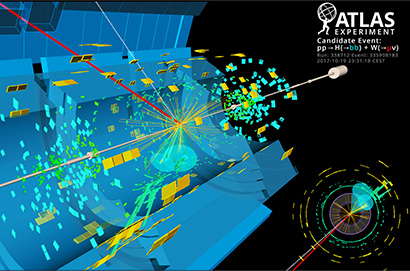Two major experiments at the Large Hadron Collider (LHC) have detected the Higgs boson transforming into two bottom quarks as it decays. This is predicted to be the most common way for Higgs bosons to decay, yet it was a difficult signal to isolate because it closely mimics ordinary background processes.
The discovery of the Higgs boson at the LHC in 2012 confirmed the existence of the Higgs field, which gives elementary particles mass. It is a fundamental part of the standard model of particle physics. The new finding is important because it opens up the possibility for scientists to closely examine the behavior of the Higgs boson, such as whether it could interact with new, undiscovered particles.
“One of our main goals is to measure the Higgs decay rates, and the dominant Higgs decay is this bottom-quark channel. About 60 percent of Higgs bosons should decay into bottom quarks,” said Jason Nielsen, professor of physics at UC Santa Cruz and associate director of the Santa Cruz Institute for Particle Physics (SCIPP). “If we measure all the predicted ways the Higgs can decay and they don't sum up to 100 percent, it could mean there is something else coupling to the Higgs, like dark matter.”
The detection of the Higgs-to-bottom-quarks decay was announced jointly by the ATLAS and CMS experiments at CERN, the European particle physics lab in Geneva, Switzerland, where the LHC is located. After several years of refining their techniques and gradually incorporating more data, both experiments finally saw evidence of the Higgs decaying to bottom quarks that exceeds the 5-sigma threshold of statistical significance typically required to claim a discovery. Both teams found their results were consistent with predictions based on the standard model.
UC Santa Cruz physicists have been at the forefront of U.S. participation in the LHC and the ATLAS collaboration. Marco Battaglia, a SCIPP research professor who is currently at CERN, led the large ATLAS group that developed the algorithms for identifying bottom quarks. Nielsen and several UCSC graduate students and postdoctoral researchers were also directly involved in the new discovery.
“Our group had been working on the analyses of the data from the ATLAS experiment, looking for evidence of Higgs decays, and we developed a new data analysis that was part of the combination that pushed us over the 5-sigma threshold,” Nielsen said. “We are also using the Higgs-to-bottom-quarks decay as a way of looking for new particles.”
A paper on the new data analysis has been accepted for publication in Physical Review D.
Higgs bosons are only produced in roughly one out of a billion LHC collisions and live only one-septillionth of a second before their energy is converted into a cascade of other particles. Because it’s impossible to see Higgs bosons directly, scientists use these secondary particles to study the Higgs’ properties. Since its discovery in 2012, scientists have been able to identify only about 30 percent of all the predicted Higgs boson decays.
The Higgs field is theorized to interact with all massive particles in the standard model, the best theory scientists have to explain the behavior of subatomic particles. But many scientists suspect that the Higgs could also interact with massive particles outside the standard model, such as dark matter. By finding and mapping the Higgs bosons’ interactions with known particles, scientists can simultaneously probe for new phenomena.
“A fraction of Higgs bosons could be producing dark matter particles as part of their decay,” said Giacinto Piacquadio, a physicist at Stony Brook University who co-leads the Higgs-to-bottom-quarks analysis group. “Because the decay of the Higgs boson to bottom quarks is so common, we can use it to put constraints on potentially invisible decays as well as use it to probe for new physics directly.”
Even though this decay is the most popular path, spotting it in the experimental data was no walk in the park. Every proton-proton collision produces a splattering of subatomic byproducts, one of the most common being bottom quarks. These bottom quarks then quickly decay into other kinds of particles, leaving behind vast showers of particles in the detectors. Tracing these particle showers back to two bottom quarks (and then figuring out which ones came from a Higgs boson) is extremely delicate and labyrinthine work.
“Being able to identify and isolate bottom quarks in the experimental data is a huge challenge and required precise detector calibration and sophisticated b-quark tagging,” said Piacquadio. “We were only able to do these analyses thanks to years of work that came before.”
To spot this process, the ATLAS and CMS collaborations each combined data from the first and second runs of the LHC and then applied complex analysis methods to the data.
“Finding just one event that looks like two bottom quarks originating from a Higgs boson is not enough,” said Chris Palmer, a scientist at Princeton University who worked on the CMS analysis. “We needed to analyze hundred of thousands of events before we could illuminate this process, which is happening on top of a mountain of similar-looking background events.”
According to Palmer, these deceptive background events made the analyses almost impossible to perform based on isolated bottom quarks alone.
“Luckily, there are a few Higgs production mechanisms that produce identifiable particles as byproducts,” said Palmer. “We used these particles to tag potential Higgs events and separate them out from everything else. So we really got a two-for-one deal with this analysis because not only did we find the Higgs decaying to bottom quarks, but we also learned a lot about its production mechanisms.”
The next step is to increase the precision of these measurements so that scientists can study this decay mode with a much greater resolution and explore what secrets the Higgs boson might be hiding.



